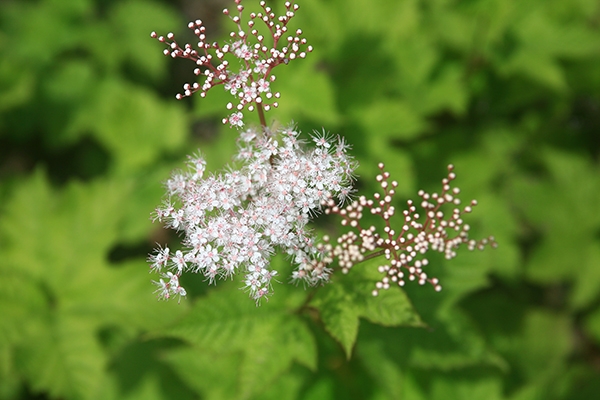Korean Meadowsweet
(Filipendula glaberrima)
Korean Meadowsweet (Filipendula glaberrima)
/
/

National Institute of Ecology
KOGL Type 1
Image By:
National Institute of Ecology
Recorded By:
Copyright:
KOGL Type 1
Copyright Notice:
Photo by: National Institute of Ecology | License Type: KOGL Type 1 | License URL: http://www.kogl.or.kr/open/info/license_info/by.do | Uploader: Storiated | Publisher: Wikimedia Commons | Title: Filipendula_glaberrima_2.jpg | Notes: ;Scientific name: Forsythia suspensa *{{ja|レンギョウ}} Place:Osaka-fu Japan {{Information| |Description = Forsythia suspensa |Source = KENPEI's photo |Date = 2007-05-13 |Author = KENPEI |Permission =GFDL,Creative Commons Attribution ShareAlike 2





Estimated Native Range
Summary
Filipendula glaberrima, commonly known as Korean Meadowsweet, is a deciduous perennial herb native to moist meadows, forest clearings, and along stream banks in Japan, Korea, and the Russian Far East. It typically grows to a height and width of 2-3 feet (0.6-0.9 meters). The plant features deeply lobed leaves and produces clusters of small, cream-colored flowers in the spring, which are moderately showy and attract pollinators. The flowering period adds ornamental value to garden settings.
Korean Meadowsweet is valued for its low maintenance requirements and its ability to thrive in a range of light conditions, from full sun to part shade. It is often used in border plantings, cottage gardens, and naturalized areas. While it prefers consistently moist soil, it can tolerate periods of dryness once established. Gardeners should be aware that in optimal growing conditions, it can spread vigorously, potentially becoming invasive. To prevent this, it may require regular division or containment measures.CC BY-SA 4.0
Korean Meadowsweet is valued for its low maintenance requirements and its ability to thrive in a range of light conditions, from full sun to part shade. It is often used in border plantings, cottage gardens, and naturalized areas. While it prefers consistently moist soil, it can tolerate periods of dryness once established. Gardeners should be aware that in optimal growing conditions, it can spread vigorously, potentially becoming invasive. To prevent this, it may require regular division or containment measures.CC BY-SA 4.0
Plant Description
- Plant Type: Herb
- Height: 2-3 feet
- Width: 2-3 feet
- Growth Rate: Moderate
- Flower Color: Cream
- Flowering Season: Spring
- Leaf Retention: Deciduous
Growth Requirements
- Sun: Full Sun, Part Shade
- Water: Low, Medium
- Drainage: Medium
Common Uses
Bee Garden, Bird Garden, Butterfly Garden, Fragrant, Low Maintenance, Rabbit Resistant
Natural Habitat
Moist meadows, forest clearings, and stream banks
Other Names
Common Names: Smooth Phlox, 터리풀
Scientific Names: , Filipendula yezoensis, Filipendula purpurea, Filipendula glaberrima, Filipendula formosa, Filipendula koreana, Filipendula multijuga var. yezoensis, Filipendula glabra, Filipendula koreana f. alba, Filipendula camschatica subsp. glaberrima
GBIF Accepted Name: Filipendula glaberrima (Nakai) Nakai